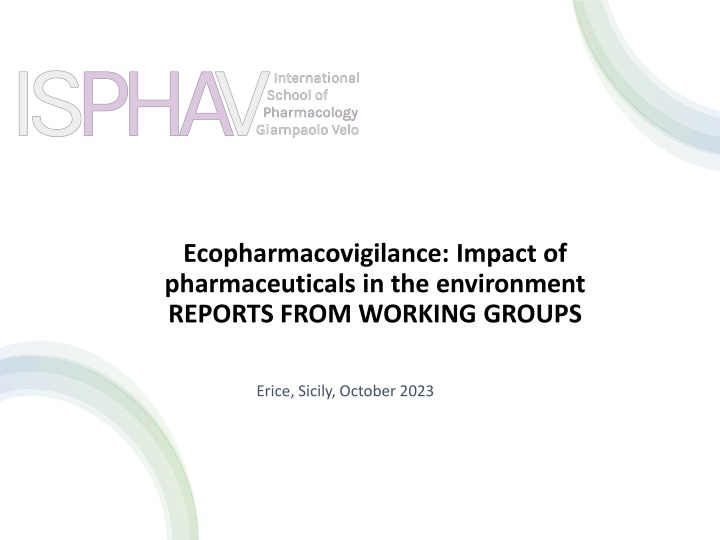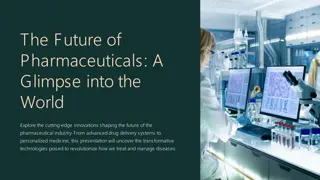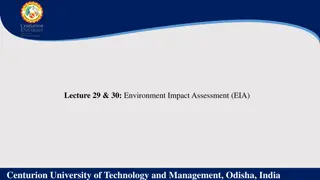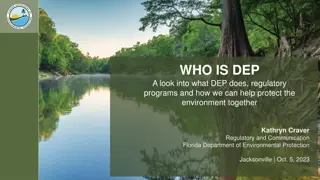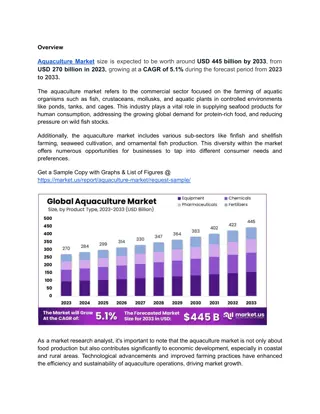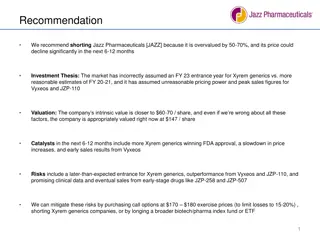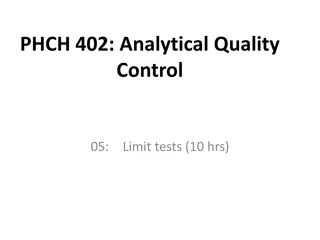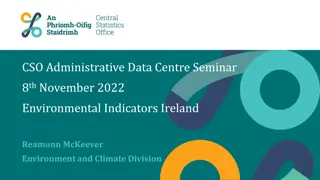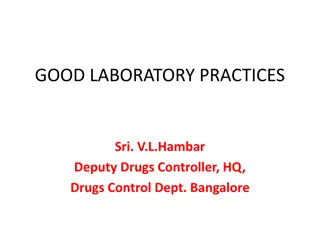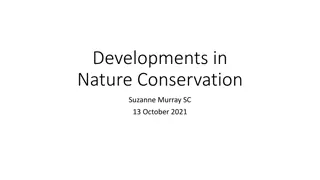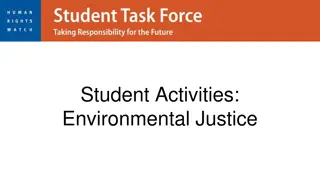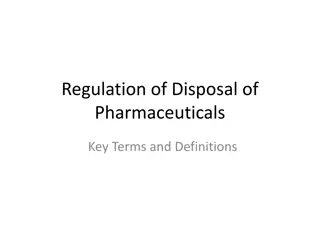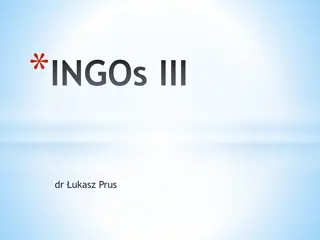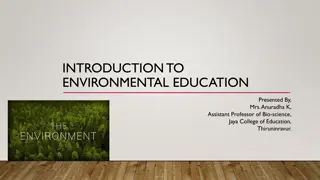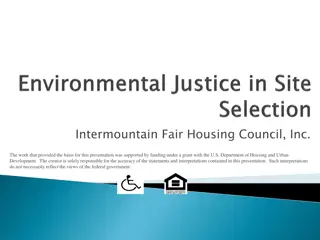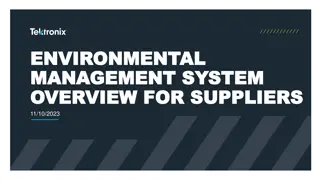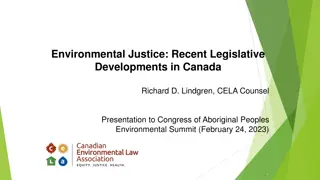Ecopharmacovigilance: Addressing Pharmaceuticals' Environmental Impact
This report highlights the discussions and recommendations from working groups at a conference on ecopharmacovigilance in Sicily. Groups focused on identifying sources of contamination, the need for regulations, standardizing methodologies, and integrating ecotoxicological tests. Key suggestions included reducing unnecessary pharmaceutical use, informing the public on correct disposal practices, and global implementation of ecoPV regulations.
Download Presentation

Please find below an Image/Link to download the presentation.
The content on the website is provided AS IS for your information and personal use only. It may not be sold, licensed, or shared on other websites without obtaining consent from the author.If you encounter any issues during the download, it is possible that the publisher has removed the file from their server.
You are allowed to download the files provided on this website for personal or commercial use, subject to the condition that they are used lawfully. All files are the property of their respective owners.
The content on the website is provided AS IS for your information and personal use only. It may not be sold, licensed, or shared on other websites without obtaining consent from the author.
E N D
Presentation Transcript
Ecopharmacovigilance: Impact of pharmaceuticals in the environment REPORTS FROM WORKING GROUPS Erice, Sicily, October 2023
Group 1 Giovanna Paolone Irene Bramke Ralph Edwards John Wilkinson Stefano Polesello Cristina Bartella Maria Rosa Valetto Vitalia Murgia Group 2 Marie Lindquist Jayesh Pandit Sergio Caroli Laura Cuzzolin Anna Barra Caracciolo Nicoletta Scarpa Elisabetta Poluzzi Paola De Ambrosis Group 3 Ugo Moretti Antonio Marcomini Raffaella Sorrentino Bruce Hugman Carlotta Lunghi Valentina Giunchi Anders Sundstrom
Session 1, group 2 We know the issue and we need to focus on what can be done: - We need to define the starting point of a specific area/Country, identify specific sources of contamination and avoid they reach ecosystems. - List and consumption data for each Country - Which are the main chemicals found? - Are there illegal pharmaceuticals in the market? - Which are the legal and illegal sources of environmental contamination? - Are there domestic and industrial WWTPs working ? - Are agricultural waste used as organic fertilizers? - What about the receiving water bodies and effluents (e.g. influenced by water scarcity)? - For humans: are receiving water used for drinkable purposes? - We find in environment substances, metabolites, mixture - The risk depends on: - the environmental concentrations of single and mixture chemicals - The effective concentrations can be evaluated using toxicological and ecotoxicolgical tests - We need to reduce use of pharmaceuticals if it is not strictly necessary and inform people about a correct use and disposal practices - We need to integrate chemical analyses with ecotoxicological tests able to evaluate single, mixture chemical and real environmental matrices (e.g. contaminated water and soil) - Interdisciplinar approach and involvement of stakeholders
Session 1, group 3 Need for standardization of methodologies used Most methods and data related to water Transparency of data (available to all researchers) Funding (public and private) Identification of drugs with the most relevant impact Identification and quantification of risk (difference from human and animals/environment) Data are lacking in this context
Session 2, group 2 - What regulation? Is current EU or US Laws known across the world? - Now only local (not global) regulations. - EcoPV regulations should be applicable and implementable globally - European Regulation is very complex to be acceptable and implementable universally. - Production - Monitoring release - Organised disposal - More transparency and accessibility of the lists. It s difficult to find PS list. - Watch list vs Priority List is very confusing- proposed to have an Icon on the package + package insert for PS medicines (something like classification labelling for chemicals)? or for all medicines? - Proposed to implement Environment Responsible Officer at each institution... and Company QPPV is responsible to have oversight over this officer? - Clinical need vs green drugs: - Sensitization of HCPs to prescribe and dispense environmentally safer meds - Companies should first address unmet clinical needs (especially severe diagnoses, even in small cohorts of patients), but they should also continue to develop greener drugs for already covered and more frequent diagnoses. - Proposal: OTC medicines only if green? - New EU directive proposal for urban waste water treatment is in progress for processing pharmaceuticals and personal care products. It should be checked for applicability universally.
Session 2, group 3 Actual regulation mainly focused on new drugs Generic (old) drugs less regulated (no responsibilities) on this risk Environmental risk should be evaluated together with the benefit/risk profile Natural product/herbals, etc not regulated
Session 3, group 1 Promote One Health approach Cautious communication; < People can be informed and educated about the small/daily actions to contribute what they can do correctly Topic can be stressed is antimicrobials use and AMR OTC Health operators technical issues, to manage different types of patients; does don t need to communicate directly the risk, the need the support by campaign and educational Education of health operator sarting from academic Therapeutic protocol which consider environnment as a key factor At the moment there is no necessity to declare a human risk Spontaneous reporting is not the right instrument for the general population; if you re a researcher the system is already ongoing and you ve to be transparent Coordinated action (in terms of institutions and health); we are Eurocentric
Session 3, group 2 Key points: How to be people not letargic (call for action) Know the problem and change awareness and behaviour Including also the ECOPV as a strategy of the enviromental risk How to do this Education to health operators (video, e-learning course, face to face training) We discuss if medical science liason could be a figure who could educate phisicians (conflict of interest). Other important actors should be the National Health System (NHS) (Ministry oh health, Regulatory Agencies, Enviromental protection Agency), Medical Association for and indipendent information E-learning training is a easy and a democratic instrument, you can reach a lot of health operators in a few time, without moving; Educational tools for children and teacher for a correct behaviuor in managing pills/syrup Comunication strategy could be also throw video for young people and general population, identifing suitable influencers who can drive these messages, short and clear message Motivate people to change behaviuor in order to respect enviroment as much as possible (concerning about disposal expired medicines) Comunicating the problem which should be a positive concept; Communication should be in a way that does not scared citizen from taking their life saving medicines video
Session 3, group 3 How to communicate/inform on environmental risks both to patients and health operators Different target population according to type of product (prescription, OTC, etc) Different tools (social media, podcast, tv advertising, pamphlet, etc) according to target (patient, health operators, age, etc) Type of risk to communicate: direct vs indirect risk Risk perception on environmental risk by both citizen and authorities (including politicians) Different products (OTC, prescription medicines, food supplements, biocides, disinfectant, etc)
Session 3, group 3 cont. When communicate the potential risks? Use of the precautionary principle (could be considered earlier but it is also relevant to dealing with public) Education can start at primary school Specific education to MD and other students Communicate evidence based risks (risks often difficult to identify, particularly for humans)
Session 3, group 3 cont. Issues around disposing of drugs plus equipment that has been used with them Clearly identify products with the higher envonmental list (priority list) Product labeling Advertising of correct disposal of medicinal products
Session 3, group 3 cont. Who inform on environmental risks (pharmacies, hospital, national Drug Agencies, etc)? Different players involved (Local authorities, Drug Agency, Ministry of health and other Ministeries) Synergy between the players Specific expertised is essential Peer effect Funding (public and private)
